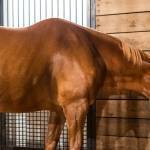Gastric Ulcers in Horses: Grading Systems Compared

In 2009, a request to separate equine gastric ulcer syndrome (EGUS) into two distinct diseases, equine glandular gastric disease (EGGD) and equine squamous gastric disease (ESGD), was made by a leading gastroenterologist in a scientific journal.1 That plea was heard the world over, and the two diseases are now referred to as individual syndromes, especially in scientific circles.
The basic pathophysiology for the development of ESGD is well defined: excessive acid exposure. Management strategies, including dietary manipulation and prophylactic supplementation with high-quality products, often keep the problem from developing. With respect to EGGD, however, the cause is far more elusive.
One well-founded method of documenting disease and gauging efficacy of treatment is through ordinal scoring systems. For ESGD, a scoring system of 0 to 4, as recommended by The Equine Gastric Ulcer Council, is typically used.2 Because of the paucity of information concerning EGGD when compared to ESGD, the aforementioned system might not be as accurate for EGGD.
With this in mind, the current recommended grading system does not involve numbers but descriptive terminology in four categories: severity (mild, moderate, severe), distribution (focal, multifocal, diffuse), shape (depressed, flat, nodular, raised), and appearance (erythematous, hemorrhagic, fibrinosuppurative).3 A second scoring approach, usually employed in research settings and called the verbal rating scale, uses a 0 to 2 scale: 0 (normal mucosa surface with no evidence of loss of mucosal integrity), 1 (mild to moderate lesion with evidence of loss of mucosal integrity), and 2 (severe lesion with evidence of loss of mucosal integrity).4 A recent study set out to determine the interobserver reliability of the two scoring systems.5
Eighty-two veterinarians responded to a questionnaire that included 20 images of glandular lesions. While the survey was anonymous, prefatory questions provided background information about the respondents, including gastroscopy experience, specialty status (specialists or primary care veterinarians), and familiarity with grading systems. The respondents were asked to grade all of the images using both the descriptive terminology and verbal rating scales. For each lesion, respondents were asked if they would recommend treatment, thereby indicating the clinical relevance.
Agreement among the veterinarians was fair to moderate for severity, distribution, appearance, and shape of lesions. Of the 82 veterinarians polled, 49 were diplomates (held advanced training or greater experience) and 33 were not. Agreement was greater among the diplomates in all categories. Lesion appearance and shape, but not distribution, was associated with a decision to treat, according to the researchers.
While researchers continue to fine-tune a unified grading system for lesions associated with both ESGD and EGGD, the benefits of gastric support have been proven. If gastroscopy reveals gastric ulceration, an appropriate course of omeprazole, as recommended by a veterinarian, typically heals the lesions. Just prior to ending the omeprazole, a research-proven antiulcer supplement should be started. Horses prone to EGUS should be maintained on the gastric-support supplement, especially when subjected to the lifestyle that might have contributed to the development of ulcers (limited forage intake, high-grain diets, stressful situations, changes in herd dynamics, etc.).
For more information about the history of EGUS, check out the proceedings of the 2018 Kentucky Equine Research Conference. The specific article, “Advances in the Understanding of Gastric Ulcers in Horses,” features an interview with prominent researcher Al Merritt, D.V.M., Diplomate ACVIM. The article begins on page 105 of the proceedings.
1Merritt, A.M. 2009. Appeal for proper usage of the term “EGUS”: Equine gastric ulcer syndrome. Equine Veterinary Journal 41:616.
2The Equine Gastric Ulcer Council. 1999. Recommendations for the diagnosis and treatment of equine gastric ulcer syndrome (EGUS): The Equine Gastric Ulcer Council. Equine Veterinary Education 11(5):262-272.
3Rendle, D., M. Bowen, T. Brazil, R. Conwell, G. Hallowell, R. Hepburn et al. 2018. Recommendations for the management of equine glandular gastric disease. UK Vet Equine 2(Suppl. 1):2-11.
4Sykes, B.W., K. Kathawala, Y. Song, S. Garg, S.W. Page, C. Underwood, et al. 2017. Preliminary investigations into a novel, long-acting, injectable, intramuscular formulation of omeprazole in the horse. Equine Veterinary Journal 49(6):795-801.
5Tallon, R., and M. Hewetson. 2020. Inter-observer variability of two grading systems for equine glandular gastric disease. Equine Veterinary Journal:13334.








